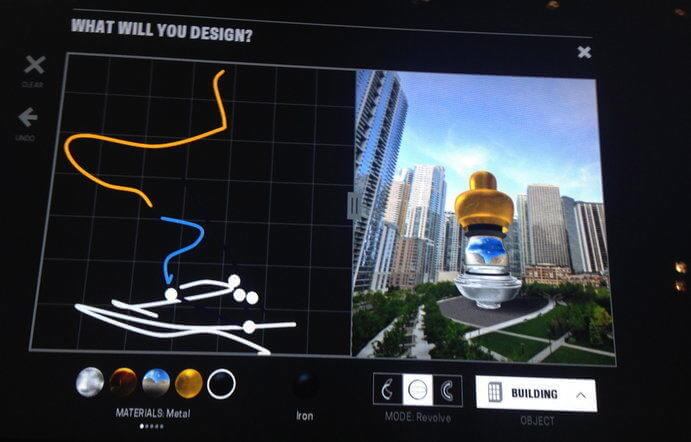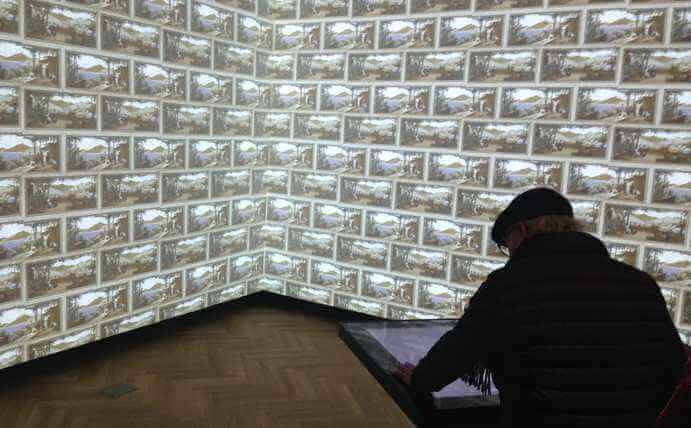The newly renovated Cooper Hewitt Smithsonian Design Museum opened its doors once again in December after a three-year closure. With the goal of updating the stately Carnegie Mansion into a 21st-century museum, the renovation incorporates interactive experiences for visitors via a host of new technologies, a transition director Caroline Baumann termed as a shift from a “museum of looking” to a “museum of doing.” Among the additions: large touchscreen tables enabling visitors to create original designs, an Immersion Room, built for the large-scale projection of the museum’s wallpaper collection, and, at some point in early 2015, new interactive pens which every visitor will receive to collect and save information as they traverse the museum.
In keeping with its focus on technology, the museum included a multimedia installation by Charlie Morrow in its inaugural exhibition, “Tools: Extending Our Reach.” Morrow’s piece, “Tool Sound Image,” a multimedia composition with true 3D Sound plus video, cycles through short, haiku-like videos of people using tools, from a typewriter to a blacksmith’s hammer to a mortar and pestle. The accompanying soundscape, using the sounds of the tools from each vignette, heightens these everyday noises not through processing or alteration, but rather through a crisp, snapshot-like verisimilitude, diffused in eight channels. Morrow’s work with spatialization led him to develop the 3D audio effect True 3D, and its effect is to create a visceral experience of sound—shifting the listener’s perception from the actuality of listening to a recording to the sensation of being enmeshed in an original soundscape.
Morrow’s soundscape work is also featured in the second floor permanent collection, where his “Birds for Bertha and Bill,” a soundscape of birds from Central Park, plays in a small room featuring the bird cage collection of the Hewitt sisters, who amassed the colorful collection of decorative objects featured in the museum at large. Even beyond the topical allusion to birds, the pairing makes sense; Morrow’s near career-long insistence on creating works for the public, in public spaces, as opposed to the concert hall, mirrors the attitude of the civic-minded founders of the museum itself, the Hewitt sisters.
In addition to Morrow’s soundscape, the museum also includes a soundscape by Richard Chartier, “Recurrence,” which plays through headphones at the side of the Tonometer on display in the “Tools” exhibit. Built in 1876, the Tonometer features four octaves of tuning forks, mounted upright in a gleaming series of rigid rows and columns. Chartier’s soundscape uses recordings of the Tonometer processed into gorgeous drones shimmering with granular detail. The dronescape balances rich layers, from a precise yet ethereal metallic high-end, to low, grounded hums that emerge almost imperceptibly, with gestural sounds in the mid-level. Occasionally a vague and drawn-out attack of a struck tuning fork will emerge, but so carefully blended in the layers that its effect is quasi-hallucinatory. Throughout percussive gamelan-like pitches punctuate the drones. There’s something striking about watching the mute Tonometer in its glass case while immersed in Chartier’s dense soundscape, an engagement of the rich possibilities of pitch while staring at a silent instrument.

Cooper Hewitt Interactive Design Tool– Photo Credit: Jennifer Stock
The alterations to the Cooper Hewitt make it an engaging and multi-sensory experience for the visitor. Even though I initially went to explore the new soundscapes, I found myself drawn to trying out some of the other interactive technologies, such as the Immersion Room and the interactive tables, which invite visitors both to explore the objects in the museum digitally and to create their own new designs. Since I can scarcely draw a proper stick figure, I was initially a little intimidated to try out the interactive designing tools. But, after taking a quick look around to assure myself that no one would see the results of my “design project,” I made a little sketch on one of the large design tablets. To my delight, the program was clever enough to turn my uncertain doodle into an entirely proper, if slightly phallic-looking building (see picture above). In the Immersion Room I cycled through twenty or so gorgeous wallpapers and admired the luminous effect of being surrounded by their sundry patterns. Throughout the museum, the presence of these interactive tools and new media shifts the visitors’ role from passive to engaged, from mere beholding to a more dynamic, hybrid experience.




















